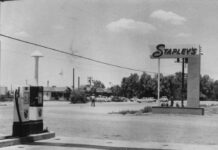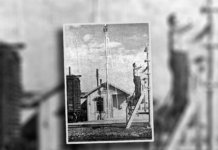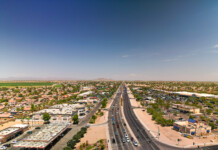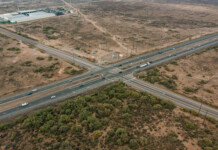By Patricia Brock and the Maricopa Historical Society
Mobile is a small community located about 15 miles west of Maricopa on State Route 238 (Mobile Road), and north of what was the Southern Pacific Railroad tracks. It is in Maricopa County and bordered by two majestic mountain ranges – the Estrella Mountains to the east and the Maricopa Mountain Range to the west.
In the 1800s, this little settlement was named Mobile when the Southern Pacific Railroad tracks were laid across southern Arizona and a siding and section house were created to provide water for steam engines.
Today, not much remains to indicate that at one time Mobile might have developed into a thriving town. In 1988, it was the proposed site for the Superconducting Super Collider and considered by the ENSCO Hazardous Waste Facility, but neither of these projects took root. However, against the wishes of many of its residents, the Butterfield Station Waste Management Facility did locate at Mobile.
First Homestead
Edison Lung, a white man who first carved out a life in Mobile, homesteaded the area around 1921 and continued to live there for the rest of his life. Lung worked for the Southern Pacific Railroad pumping water for the steam engines. When the railroad transferred him to Yuma, he absolutely refused to go, quit his job and laid down stakes at Mobile catering to railroad personnel and travelers.
Records show Lung filed an application to enlarge his homestead in 1922 and received a title to that land in 1925. His homestead consisted of a frame and stucco house, a store located downstairs and a post office with sleeping quarters on the second floor. The homestead had a gas station, a cow barn, a chicken coup and a storeroom. His wife ran the post office and made a living by providing services to travelers and railroad employees.
Edison Lung raised cattle, hogs and chicken on his homestead. Around 1935, he decided to modernize the property and bought a Delco electric generator that provided the family with lighting and the use of a few appliances. Records also show he and his family motored to Maricopa to dances at the Maricopa Hotel and to other recreational events throughout the 1930s.
An African American Community
During the late 1920s and early ‘30s, Mobile became an African American settlement as people began to homestead the land. According to Mark Swanson (An Archaeological Investigation of the Historic Black Settlement at Mobile, Arizona), the population in the 1930s was between 100 and 150 and consisted of mainly black settlers. Most of these early settlers did not work for the railroad but came from Oklahoma or Texas by way of Phoenix.
The first of the successful African American homesteaders were Lee Elliot Williams (homestead awarded in 1933); Richard Cobb Williams (homestead awarded in 1933); Homer Abraham Williams (homestead awarded in 1933); and Willis Thomas, Hezekiah McGriff, Eli Weddington, James Manor, and the Israel Nelson families.
Education
The first school in Mobile contained grades 1-8 and consisted of two railroad cars placed end to end. White children went to school in one car and black children went to school in the other car. Later, the white children were transferred to a wood frame schoolhouse that was moved from Rainbow Valley (1936-37) and placed near the home of Edison Lung. It continued to educate these children up to the 1960s.
The black residents of Mobile built a small schoolhouse, Nelson Elementary School, for their children. When the community started to grow and needed a bigger school, the government built a much larger one in the same location. After eighth grade graduation, children were bused to Percy L. Julian or South Mountain High School.
Growing up in Mobile
In an oral history interview with the Deck brothers, Pierre and Daniel, and their lifelong friend Fezel Adams, Pierre Deck recalled what it was like growing up in Mobile: “One thing about Mobile, I don’t care who you were, you were family. If you needed something, you got it. I don’t care how it came to you, you got it, you didn’t have to pay it back. It was just one big family.”
Pierre Deck said, “I watched my grandfather come from nothing to having something … to be proud of who you are. You just do the right thing and that’s how I was raised. In Mobile everybody stood out.”
Daniel Deck said, “Nobody had running water or electricity. They hauled the water. No electricity, dirt floors, no windows, a potbellied stove you stuck wood into. My grandma and grandpa, they worked pretty hard. When sand was dumped out there, snakes would just lay down and sleep. You had to walk out to the outhouse; you didn’t have a bathroom. If you encountered a snake, you would just jump it or go around. There was not an animal around that the snake would back up from! You live here and they live over there. You had to look under the covers and under the bed and everywhere. You might get out of bed and they would be sleeping right next to you.”
Today, Mobile has a population of less than 100 people who are mostly white. Besides the Butterfield Waste Management Facility, there is a private airport, Lufthansa, located to its north that is used for training pilots.
This story appears in the March issue of InMaricopa.

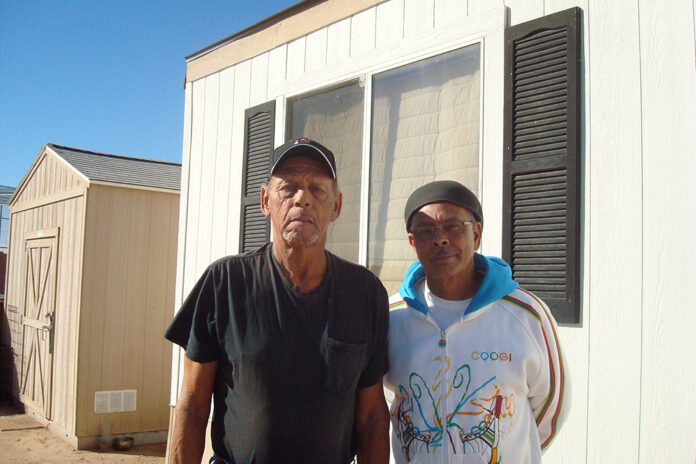
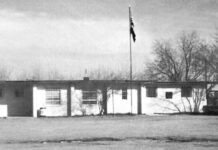
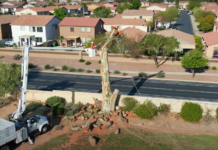
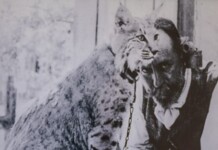
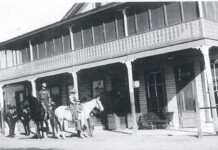
![HISTORY: Politics and prejudice First Lady Elanor Roosevelt visits the Gila River Camps. [Maricopa Historical Society]](https://www.inmaricopa.com/wp-content/uploads/2023/12/Eleanor_Roosevelt_at_Japanese_Interment_Center-1-218x150.gif)
